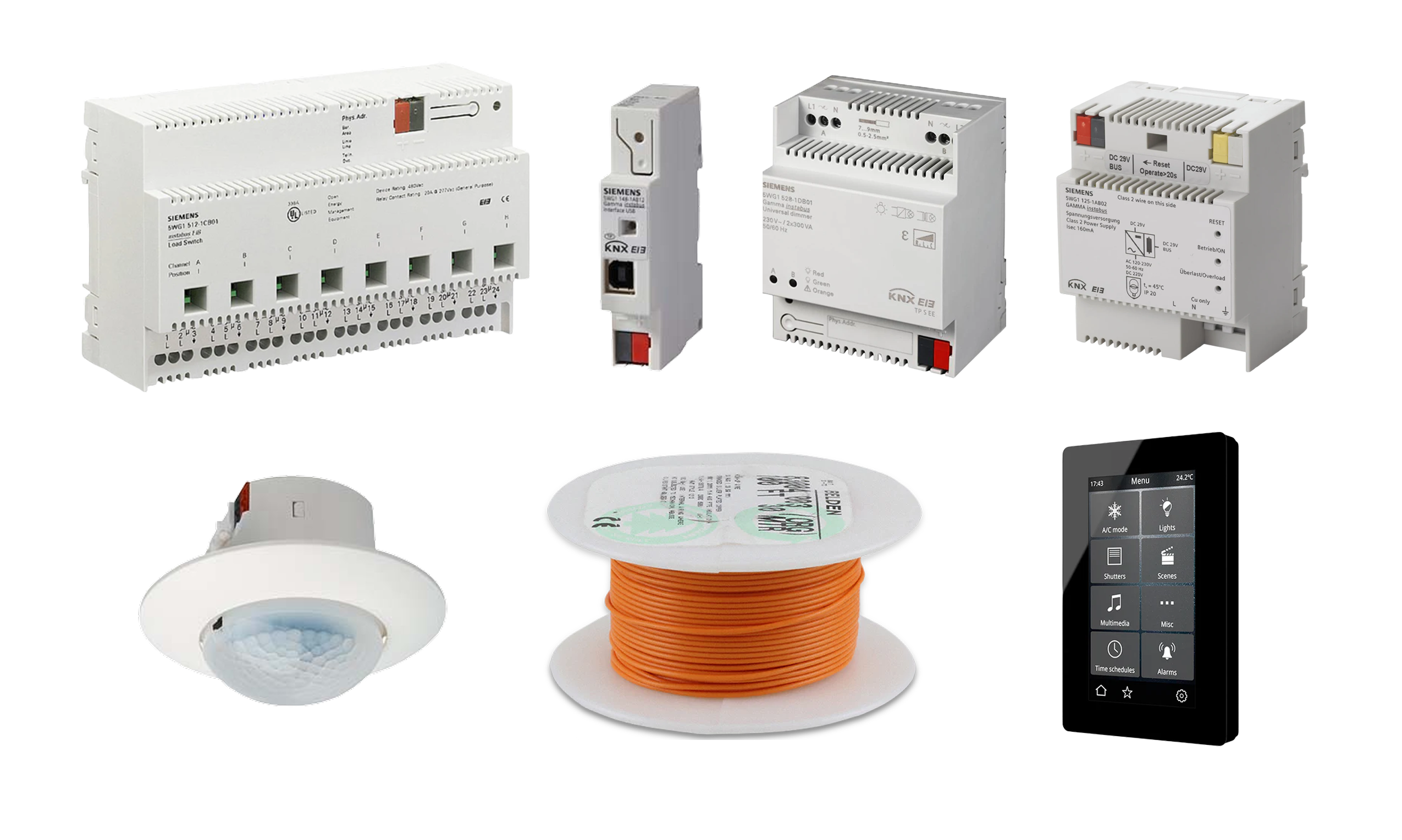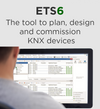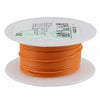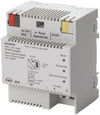- Your one stop shop for KNX devices in the USA 🇺🇸
- (+1) 786 956 6821
- support@knxsupply.com
- Store Location
- Sign in or Register
- Home
-
Categories
- System Devices
- Switching/Shutter Actuators
- Dimming Actuators
- HVAC
- Binary Inputs
- Keypads
- Gateways
- Enclosures and Boxes
- Occupancy Sensors
- Visualization Systems and Touch Panels
- Weather Sensors
- Drivers and ECGs
- Special Sensors
- HVAC
- Accessories
- Cable
- Expert Picks
- KNX Certified Training
- Newest Products
- Best Selling Products
Brands
- Articles
- Contact Us
- Home
- All Collections
- Best Selling Products
Best Selling Products
Presence detector with brightness sensor for detection of motion and presence for ceiling mounting
- Contrast measurement of brightness
- Presence motion detection up to Ø8 m
- Flush mounted installation in ceilings with wall box or clamps
- Integrated IR receiver for IR remote control
Functions with commission with ETS
- Three independent output channels with four commands each in case of motion detection
- Integrated 2-level light controller (switching)
- Integrated constant light level controller for up to five lighting groups including
- Usage of motion detector as standalone mode or extension mode to cover wider areas
- Independent output channel for HVAC applications
Presence detector with brightness sensor for detection of motion and presence for ceiling mounting
- Contrast measurement of brightness
- Presence motion detection up to Ø8 m
- Flush mounted installation in ceilings with wall box or clamps
- Integrated IR receiver for IR remote control
Functions with commission with ETS
- Three independent output channels with four commands each in case of motion detection
- Integrated 2-level light controller (switching)
- Integrated constant light level controller for up to five lighting groups including
- Usage of motion detector as standalone mode or extension mode to cover wider areas
- Independent output channel for HVAC applications
Blind/Shutter control with one output of a KNX Multi IO.
- The device may be used for permanent interior installations in dry locations or within distribution boards with DIN rail.
Serial Interface and ObjectServer for KNX Bus.
Application
The KNX Serial Interface BAOS 870 serves as a simple integration solution for non-KNX devices.
Designed as a RS-232 interface, the KNX Serial BAOS 870 uses the proven FT1.2 protocol (PEI 10) as message format.
Moreover, the device supports the BAOS protocol for accessing data points.
This allows non-KNX devices to be fully integrated into a KNX network via a RS-232 link.
For a quick start, free SDKs, a demonstration tool as well as an ETS entry with 250 group objects are available.
Furthermore, individual ETS representations for OEM versions can be created.
Interface and ObjectServer between LAN and KNX Bus.
Application area
The KNX IP BAOS 777 integrates a web server for the KNX installation.
This allows the visualization in a web browser on a PC or mobile device.
The email function allows the notification e.g. in case of an alarm.
The integration of a Date & Time Server (NTP) allows to obtain date and time automatically via the Internet
and to synchronize the KNX installation.
Extensive time functions offer a powerful KNX time switch with week function.
The configuration is done with the ETS software.
Compact bus powered Interface and ObjectServer between LAN and KNX-Bus.
Application area
The KNX IP BAOS 774 is used as Interface for connecting to KNX both on telegram level (KNXnet/IP Tunneling) and on data point level (KNX Application Layer).
Clients can directly access Group Objects via either a Binary Protocol (over TCP/IP or UDP/IP) or via JSON (Java Script Object Notation) Web Services.
The device is configured with the ETS and supports up to 1000 Group Objects.
10 simultaneous client connections are supported.
BAOS is an acronym for “Bus Access and Object Server”.
It is possible to connect to the KNX bus everywhere over LAN.
Bus connection over the internet with KNX IP BAOS 774 is also possible.
The device supports 5 simultaneous KNXnet/IP tunneling connections.
The buttons are for diagnostic purposes.
The LEDs indicate
the operating status and communication errors on the bus.
Power is supplied via the KNX bus
Compact bus powered Interface and ObjectServer between LAN and KNX-Bus.
Application area
The KNX IP BAOS 773 is used as Interface for connecting to KNX both on telegram level (KNXnet/IP Tunneling) and on data point level (KNX Application Layer).
Clients can directly access Group Objects via either a Binary Protocol (over TCP/IP or UDP/IP) or via JSON (Java Script Object Notation) Web Services.
The device is configured with the ETS and supports up to 250 Group Objects.
10 simultaneous client connections are supported.
BAOS is an acronym for “Bus Access and Object Server”.
It is possible to connect to the KNX bus everywhere over LAN.
Bus connection over the internet with KNX IP BAOS 773 is also possible.
The device supports 5 simultaneous KNXnet/IP tunneling connections.
The buttons are for diagnostic purposes.
The LEDs indicate the operating status and communication errors on the bus.
Power is supplied via the KNX bus.
Wireless KNX IP interface.
Application area
The KNX IP Interface 740.1 wireless serves as a wireless interface to the KNX bus based on WLAN.
The device can be used as a programming interface for the ETS® and is a wireless alternative to USB or wired IP interfaces.
The bus access via WIFI allows the installer to move freely in the building with his laptop to a large extent.
The KNX IP Interface 740.1 wireless has an integrated WIFI access point to which the laptop can connect.
Alternatively, the device can be connected to an existing WIFI in client mode, the connection can be made via WPS (WIFI Protected Setup).
The device supports the security standard WPA2.
Power is supplied via the KNX bus.
The device works according to the KNXnet/IP specification.
It can be used with the ETS® from version 5.
With KNX IP interface, bus powered.
Application area
The KNX Modbus TCP Gateway 716 secure is a compact gateway between KNX TP and modbus TCP with 250 freely configurable datapoints.
The device enables easy integration of modbus devices that support the TCP protocol via IP and can act as a modbus master or slave.
As master the device can address up to 5 slave devices.
The assignment between KNX objects and modbus registers can be configured via parameters in the ETS
without an additional tool.
Two buttons and three LEDs allow local operation and visualization of the device status.
Furthermore, the device can be used as a programming interface to connect one or more PCs to the KNX bus (e.g. for ETS®).
Power is supplied via the KNX bus.
The device supports KNX Security.
Compact KNX Line Coupler.
Application area
The KNX LineCoupler 650 is a KNX line coupler in a compact design.
It connects two KNX bus segments (for example, a KNX line with a KNX area).
The device has an extended filter table for main group 0 … 31 and ensures a galvanic isolation between the lines.
The coupler supports KNX longframes and is compatible with the ETS® software (ETS 4.2 or higher).
The buttons on the front panel allow disabling the telegram filter for testing purposes.
The LEDs indicate operating conditions as well as communication errors on the KNX bus.
The power is supplied via the KNX bus (main line).
KNX IP Multi IO with 48 configurable In- and Outputs.
Application area
The KNX IP Multi IO 580 is a universal binary interface for building control.
It provides 48 I/O lines.
Each line can be used as binary input as well as binary output.
The peripherals can be fed by an external voltage of 24 V⎓.
Channels which are configured as inputs can be used to control lights or blinds via the KNX network.
They also can be used to count impulses, e.g. as interface for energy meters.
Channels which are configured as outputs can directly drive signal LEDs, external coupling relays (e.g.
590) or jalousie relays (592).
The device works using the medium KNX IP.
It can be configured using the ETS (Version 4.2 or higher) with native parameters and standard group objects.
Also the KNX addressing scheme, based on individual device
address and group objects, is unchanged.
An easy to read OLED display on the front panel enables a manual operation to test the installation.
Combined dimming/switching actuator with 1 dimming output for active electronic ballasts and 1 switching output.
Application area
The KNX IO 546.1 secure (1D1O) is a compact combined dimming/switching actuator with 1 dimming output for active electronic ballasts with a 0/1-10V interface and 1 bi-stable relay output.
The dimming actuator can be used for several active electronic ballasts e.g. for LED panels or stripes.
The configuration allows controlling the channel by switching, rel.
Dimming and dimming value.
Several comfort functions are integrated as well, including scenes, slumber fading, staircase light and sequencer.
The switching actuator provides the function for universal outputs including scene control, timer, staircase lighting and heating valves (PWM for thermoelectric valve drives).
KNX LED dimming actuator 4-fold with constant current.
Application area
The KNX IO 536 CC (4D) is a compact RGB / RGBW / Tunable White dimming actuator with 4 outputs (constant current).
The dimming actuator can be used e.g. for LED panels or stripes with RGB / RGBW / Tunable White configuration or as 4 independent dimmer channels.
Every configuration allows controlling the channel by switching, rel.
Dimming and dimming value.
Several comfort functions are integrated as well, including scenes, slumber fading, staircase light and sequencer.
KNX LED dimming actuator 4-fold with constant voltage.
Application area
The KNX IO 534 CV (4D) is a compact RGB / RGBW /Tunable White dimming actuator with 4 PWM outputs.
The dimming actuator can be used e.g. for LED panels or stripes with RGB / RGBW / Tunable White configuration or as 4 independent PWM dimmer channels.
Every configuration allows controlling the channel by switching, rel.
Dimming and dimming value.
Several comfort functions are integrated as well, including scenes, slumber fading, staircase light and sequencer.
Blind actuator with 2 binary inputs.
Application area
The KNX IO 520 (1J2I) is a compact blind actuator with two additional binary inputs.
The actuator is used to control a blind, a shutter or a window drive.
The relay contacts are electrically interlocked.
The inputs can be connected to conventional switches with an external voltage of 12 to 230 V.
In the not configured state the binary inputs control the actuator channel.
Via commissioning the device using ETS® software the binary inputs can be used independently.
Two push buttons and three LEDs allow a local operation and a visualization of the device state.
In addition to the output and input channels the device includes 16 independent functions for logic or timer control.
Switching actuator with 1 output and 2 binary inputs.
Application area
The KNX IO 511.1 secure (1O2I) is a compact switching actuator with 1 bi-stable output and 2 binary inputs.
The actuator provides the function for universal outputs including scene control, timer, staircase lighting and heating valves (PWM for thermoelectric valve drives).
The inputs can be connected to conventional switches with an external voltage of 12 to 230 V.
In ex-factory settings the inputs are connected internally to the actuator.
The actuator combined with input B1 serves as a latching relay.
Input B2 is used for zero crossing detection.
Switching actuator with 2 outputs.
Application area
The KNX IO 510.1 secure (2O) is a compact switching actuator with 2 bi-stable relay outputs.
The actuator provides the function for universal outputs including scene control, timer, staircase lightning and to control heating valves (PWM for thermoelectric valve drives).
Two push buttons and three LEDs allow a local operation and a visualization of the device state.
In addition to the output channels the device includes 16 independent functions for logic or timer control.
The device supports KNX Data Security.
Push button for extra low voltage for MATCH 55 series.
The 24V Push Button 436 is a push button for direct connection to push button inputs of e.g. smart home control panels, PLC controls or push button interfaces of any bus system.
The device is available with one or two rockers.
Each rocker offers two pressure points (up/down).
A pluggable connection cable is included in the scope of delivery.
The device is part of the MATCH 55 push button series.
With the supplied installation kit, the push button fits mechanically to numerous switch ranges available on the market with internal dimensions of 55 mm.
The push button is characterized by soft and quiet button press.
The optional terminal block enables the screwless connection of cables with a cross section of up to 0.75 mm².
KNX TP Push Button Interface with KNX Data Security.
Application area
The KNX TP Push Button Interface 420 secure is a push button interface for the KNX bus.
It is suitable as a binary input for connecting up to four conventional push buttons or potential-free contacts.
In addition, the device offers two outputs for LEDs.
A pluggable connection cable is included in the scope of delivery.
The integrated push buttons and LEDs allow a quick test of the configuration.
The application offers extensive functions for switching, dimming, shutter, valuator, scene and color control as well as sequence controllers and scalable pulse counters.
Each channel can be configured individually.
The flexible operating concept also allows different functions on one channel depending on the setting.
In addition, the device contains 10 independent logic or time functions.
The device supports KNX Data Security.
Binary input with 4 channels to control lights, shutter etc. Inputs suitable for dry contacts.
Application area
The KNX IO 411 (4Ii) is a compact binary input with 4 channels to control lights, shutter etc.
With conventional switches or contacts.
Inputs are designed for dry contacts.
Using as impulse counter is possible as well.
It can be used to connect energy meters with S0 output or anemometers.
Two push buttons and three LEDs allow a local operation and a visualization of the device state.
In addition to the input channels the device includes 16 independent functions for logic or timer control.






















































